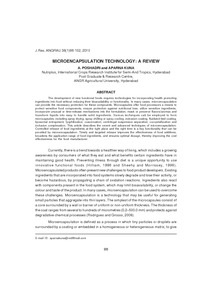Microencapsulation technology: A review
Abstract
The development of new functional foods requires technologies for incorporating health promoting ingredients into food without reducing their bioavailability or functionality. In many cases, microencapsulation can provide the necessary protection for these compounds. Microcapsules offer food processors a means to protect sensitive food components, ensure protection against nutritional loss, utilize sensitive ingredients, incorporate unusual or time-release mechanisms into the formulation, mask or preserve flavors/aromas and transform liquids into easy to handle solid ingredients. Various techniques cab be employed to form microcapsules, including spray drying, spray chilling or spray cooling, extrusion coating, fluidized-bed coating, liposomal entrapment, lyophilization, coacervation, centrifugal suspension separation, cocrystallization and inclusion complexation. This article describes the recent and advanced techniques of microencapsulation. Controlled release of food ingredients at the right place and the right time is a key functionality that can be provided by microencapsulation. Timely and targeted release improves the effectiveness of food additives, broadens the application range of food ingredients, and ensures optimal dosage, thereby improving the cost effectiveness for the food manufacturer

